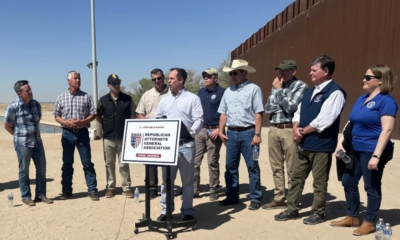border
Migrant Drug Seizures by Border Patrol: An Astonishingly Rare Occurrence, Data Reveals

A recent analysis by the Project On Government Oversight (POGO) reveals that a minuscule fraction of migrants apprehended by U.S. Border Patrol are found carrying drugs. The study examined Customs and Border Protection (CBP) data from fiscal years 2022 to 2024, uncovering that, out of over 5.8 million encounters, drugs were seized from only 249 individuals.
Marijuana accounted for more than half of these cases. Alarmingly, just one in 53,965 migrants was caught with drugs other than marijuana. For context, the likelihood of dying from a bee sting is one in 41,076.
In the El Paso Sector, which covers Far West Texas and all of New Mexico, Border Patrol agents reported 31 drug seizures among nearly 1 million migrants during the same fiscal period. Seizures included cocaine from 16 migrants, marijuana from 11, and methamphetamines from five, with no opioids, including fentanyl, detected.
POGO utilized publicly available data to analyze the frequency of drug-related encounters with migrants, distinguishing these interactions from those involving U.S. citizens. The data is often buried in lengthy spreadsheets within CBP’s documents library and reflects only limited instances of drug seizures tied to migrants.
In stark contrast, a public-facing CBP portal showcases significantly higher numbers of “drug seizure events,” but lacks crucial information on the citizenship status of those involved. This discrepancy persists despite official narratives during the Trump administration that linked illegal migration with increased drug trafficking.
Patrick Eddington, a senior fellow at the Cato Institute, criticized this narrative as “deliberate falsehoods” aimed at justifying heightened border security. Eddington emphasized that the data contradicts claims that migrants are responsible for the drug crisis.
A recent Ipsos poll revealed that more than half of Republicans incorrectly believe most fentanyl entering the U.S. is smuggled by migrants. This misperception highlights the effectiveness of misleading narratives regarding drug transport.
Comprehensive data from CBP indicates that the majority of illegal drugs come through official ports of entry, primarily carried by U.S. citizens. A 2023 Cato Institute study noted that 86% of fentanyl seizures at the border involved U.S. nationals. Additionally, a Government Accountability Office review from 2016 to 2020 showed that 91% of drug seizures involved U.S. citizens.
Despite the factual disparities, former President Trump announced a national emergency at the southern border in January, citing drug-related deaths as a justification for immigration restrictions. He claimed that undocumented individuals are bringing unprecedented levels of crime and drugs into the U.S.
The POGO analysis further uncovered inconsistencies in CBP’s drug seizure data, particularly noting that accessible information often fails to distinguish between drug seizures linked to migrants and those involving U.S. citizens. This lack of clarity obscures the realities surrounding drug transport into the country.
CBP’s spokesperson declined to clarify the methodologies behind their data reporting but asserted that the agency can provide statistics upon request. Advocacy groups argue that this obfuscation serves to bolster funding for border patrol efforts based on exaggerated threats.
Experts contend that faulty data can lead to further misinformation and scapegoating of migrants, complicating the conversation around immigration and drug trafficking. Effective data management and transparency are critical to countering these misconceptions.

















